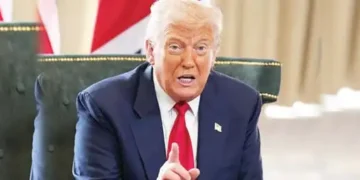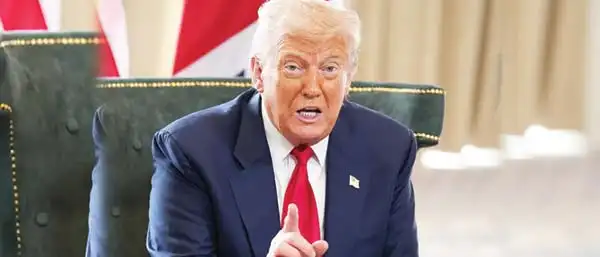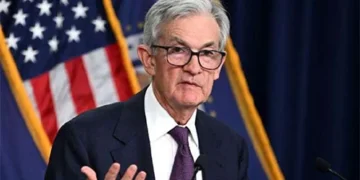Blitz Bureau
NEW DELHI – In the quiet, wood-panelled boardrooms of the nation’s Capital and the bustling trading floors of Mumbai, the conversation is dominated by a single, unnerving figure: 25 per cent. This is the magnitude of the tariff threat from US President Donald Trump, a proposed levy on all Indian goods that is no longer a distant abstraction but a clear and present danger to India’s economic ambitions.
The mood in New Delhi today is one of grim resolve. The threat of a trade war with the United States, India’s largest trading partner by a wide margin, has forced a reckoning. The country’s entire growth story, predicated on a stable global order and expanding trade, is now facing its most significant external challenge in a generation. At stake is not just the flow of goods across the Pacific, a trade relationship worth nearly $192 billion, but the very viability of the ‘Developed India @ 2047’ vision.
For years, the narrative has been one of ascendancy. But a blanket 25 per cent tariff acts as a sudden, vicious plot twist. The math is brutal. Respected analyses, like that from the Peterson Institute for International Economics, suggest a collapse in US-bound exports by as much as a third in the first year. This is not a flesh wound; it’s a direct blow to the heart of the economy.
The pain would begin in the ports and ripple outwards, hitting the very sectors that were meant to power India’s rise. The ‘Make in India’ dream of becoming an electronics powerhouse would collide with the reality of uncompetitive prices.
The textile mills and apparel factories, which provide jobs for millions, would be priced out of their biggest market, silenced by the stroke of a pen in Washington. Even India’s celebrated pharmaceutical industry, the “pharmacy of the world,” would find its margins squeezed, threatening the capital needed for future innovation. The gems and jewelry sector, a massive foreign exchange earner and an employer of highly skilled artisans, would see decades of market development undone.
“This isn’t just about export numbers; it’s about derailing the structural transformation of the Indian economy,” a senior commerce ministry official said, speaking off the record because he was not authorised to talk to the media. “Every projection we have, every incentive we offer to foreign companies, is based on access to global markets. If our primary market effectively shuts its doors, we have to redraw the entire map.”
Economic threat
This economic threat extends beyond the immediate trade figures, striking at the heart of India’s long-term strategic planning. The ‘Developed India @ 2047’ mission is fundamentally an investmentdriven narrative. It requires a stable policy environment, robust investor confidence, and seamless integration into global value chains to attract the trillions of dollars needed for its infrastructure and industrial goals.
A trade war with its largest partner creates the polar opposite of this environment: radical uncertainty. It deters the foreign direct investment (FDI) that India desperately needs. Global corporations that saw India as a viable “China plus one” manufacturing hub for the US market would immediately shelve or reconsider their plans. The Production Linked Incentive (PLI) schemes, designed with great fanfare to boost domestic manufacturing in key sectors, would lose a significant part of their financial logic.
A torpedo
“Let’s be clear: this isn’t a negotiation tactic; it’s a torpedo aimed at the hull of our growth story,” a former senior NITI Aayog official commented. “You cannot aim for a $30 trillion economy by 2047 while being embroiled in a trade conflict with your biggest customer. The two objectives are mutually exclusive. The tariff threat alone is enough to make long-term investors pause and reassess their India exposure.” The dilemma for New Delhi is acute.
The pressure for a strong response would be immense, likely involving retaliatory tariffs on key American products. Historically, targets have included agricultural goods like almonds and apples, and high-profile products like motorcycles, chosen specifically to apply political pressure in the US. However, this path is fraught with economic peril. Retaliation would inevitably lead to higher prices for Indian consumers and businesses, fuelling domestic inflation and disrupting supply chains for industries dependent on American inputs. It is a classic case of a double-edged sword, where the act of defending oneself inflicts a significant self-wound.
Perhaps most dangerously, the economic friction threatens to fracture the deep strategic partnership cultivated between the world’s two largest democracies. This alliance, fostered by both Democrats and Republicans and solidified through initiatives like the Quadrilateral Security Dialogue (Quad), is seen as a critical bulwark against China’s rising assertiveness in the Indo-Pacific. A bitter and public trade feud would erode the trust that is the bedrock of this strategic relationship.
“For years, the US and India have been building a partnership based on shared democratic values and a shared concern about China’s rise,” commented a former Indian ambassador to the United States. “A trade war driven by transactional interests would poison that well. It would weaken collaborative platforms like the Quad and inadvertently provide a strategic opening for Beijing. It would be a strategic own-goal of epic proportions.”
There is still time
As of today, no tariffs have been imposed. There is still time, however brief, for diplomacy. Back-channel talks are undoubtedly underway, as India prepares a case for why a stable, prosperous India is in America’s strategic interest. Simultaneously, the push to diversify trade away from the US has taken on a frantic urgency. Trade delegations are being dispatched, and free trade agreements that have languished for years are being re-examined with newfound purpose.
For now, the Indian economy holds its breath. Businesses are modelling for the worst-case scenario, and the government is weighing its limited options. The 25% threat has done more than just challenge economic forecasts; it has forced a hardheaded reassessment of India’s vulnerabilities on a global stage and the immense difficulty of navigating a world where the rules of trade can be rewritten overnight. The resilience and strategic foresight demonstrated now will be critical in determining whether India can withstand the storm and keep its long-term ambitions on track.






























